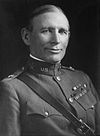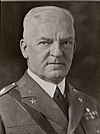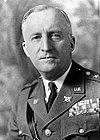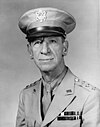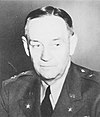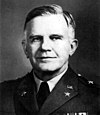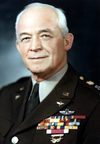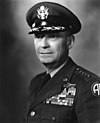Deputy Chief of Staff of the United States Army
Appearance
This article needs additional citations for verification. (May 2020) |
This article may be very hard to understand. (May 2020) |
The office of Deputy Chief of Staff of the United States Army was organized under the office of the Chief of Staff of the United States Army which existed between 1921 and 1948 before being disbanded in favor of the Vice Chief of Staff of the United States Army.
The office was established administratively in 1921.[1]
From 1921 to 1939 this office had no statutory basis for existence, an attempt was made to rectify this in the 3 June 1938 amendment to the National Defense Act of 1920. However, it failed to correct it.
Duties
[edit]The duties of the office were to "will assist the Chief of Staff and . . . act for him . . . will report directly to the Secretary of War in all matters not involving the establishment of military policies."
List
[edit]| No. | Portrait | Deputy Chief of Staff of the United States Army | Took office | Left office | Time in office |
|---|---|---|---|---|---|
| 1 | Major General James Harbord (1866–1947) | 5 December 1921 | 31 December 1922 | 1 year, 26 days | |
| 2 | Major General John L. Hines (1868–1968) | 1 January 1923 | 31 December 1924 | 1 year, 365 days | |
| 3 | Major General Dennis E. Nolan (1872–1956) | 1 January 1925 | 31 December 1926 | 1 year, 351 days | |
| 4 | Major General Fox Conner (1874–1951) | 1 January 1927 | 30 November 1927 | 333 days | |
| 5 | Major General Briant H. Wells (1871–1949) | 1 December 1927 | 8 March 1930 | 2 years, 97 days | |
| 6 | Major General Preston Brown (1872–1948) | 9 March 1930 | 11 October 1930 | 215 days | |
| 7 | Major General Ewing E. Booth (1870–1949) | 12 October 1930 | 21 December 1930 | 70 days | |
| 8 | Major General George Van Horn Moseley (1874–1960) | 22 December 1930 | 22 February 1933 | 2 years, 62 days | |
| 9 | Major General Hugh A. Drum (1879–1951) | 23 February 1933 | 1 February 1935 | 1 year, 343 days | |
| 10 | Major General George S. Simonds (1874–1938) | 2 February 1935 | 28 May 1936 | 1 year, 116 days | |
| 11 | Major General Stanley D. Embick (1877–1957) | 29 May 1936 | 30 September 1938 | 2 years, 124 days | |
| 12 | Brigadier General George C. Marshall (1880–1959) | 16 October 1938 | 30 June 1939 | 257 days | |
| 13 | Brigadier General Lorenzo D. Gasser (1876–1955) Acting | 1 July 1939 | 30 May 1940 | 334 days | |
| 14* | Major General William Bryden (1880–1972) *Serving Simultaneously | 1 June 1940 | 16 March 1942 | 1 year, 288 days | |
| 14* | Major General Richard C. Moore (Additional Deputy Chief of Staff) (1880–1966) *Serving Simultaneously | 22 July 1940 | 8 March 1942 | 1 year, 229 days | |
| 14* | Lieutenant General Henry H. Arnold (Acting Additional Deputy Chief of Staff for Air) (1886–1950) *Serving Simultaneously | 11 November 1940 | 8 March 1942 | 1 year, 117 days | |
| 15 | Lieutenant General Joseph T. McNarney (1893–1972) | 9 March 1942 | 21 October 1944 | 2 years, 226 days | |
| 16 | Lieutenant General – General Thomas T. Handy (1892–1982) | 22 October 1944 | 30 August 1947 | 2 years, 312 days | |
| 17 | Lieutenant General Joseph L. Collins (1896–1987) | 1 September 1947 | 14 November 1948 | 1 year, 74 days[2] |
References
[edit]- ^ "Chief of Staff: Prewar Plans and Preparations". United States Army Center of Military History. Retrieved 2020-05-23.
- ^ Hewes, James E. (1975). From Root to McNamara: Army organization and administration, 1900-1963. United States of America: Center of Military History, United States Army. p. 389. OCLC 2119052.



